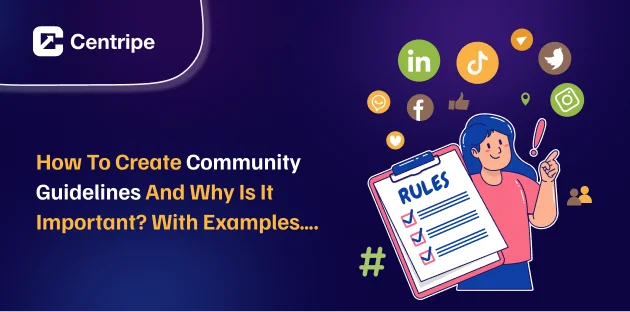According to 2025 Forrester insights, active involvement in communities with clear management practices leads to 78% higher customer retention.
Brands create a community to know their customers well, to share important updates, and even have fun with them.
Community means a group of people of the same or different demographics. So everyone has to follow rules and regulations in order to maintain dignity.
Hence, community guidelines are required.
This comes under one of the engagement strategies that every brand follows.
What Are Community Guidelines?

There are two effects that a community faces.
When everyone is well-behaved, more members will join, and the community gains a positive reputation.
Some members spread negativity, making others uncomfortable. This leads them to leave the community and eventually the brand.
Community guidelines are a set of basic rules that help everyone get along in a group or online space.
These rules tell everyone how to behave nicely and treat each other with respect.
They explain what you can and cannot do. For example:
- Be kind and respectful to others
- Don’t bully or hurt anyone’s feelings
- Don’t share mean or harmful messages
- Don’t spam (send the same message over and over)
- Keep other people’s private information safe
- Don’t break any laws
Why Are Community Guidelines Important?
1. Keeping Everyone Safe

Community should be a safe space where everyone feels comfortable. Those related to social media community management should make everyone understand the rules.
Members should not worry about being bullied or treated badly in any way.
When the rules are clear, they stop arguments, mean behavior, and spam even before they start.
2. Building Trust
85% of business owners believe clear community rules increase trust.
When members trust the community, they wish to stay longer and become more loyal towards the brand.
With interactive posts, you draw in customers to the community, and by making them feel important, you make them stick with you for a lifetime.
3. Understanding the Rules
When the rules are clear, everyone knows what’s okay and what’s not.
Community guidelines let both members and moderators understand the boundaries.
This creates a friendly atmosphere where people can talk and work together.
4. Keeping Members Active
Communities with clear rules keep people coming back. In fact, 57% of organizations measure success by counting how many people visit each month. When rules are clear and followed, more people stay active and engaged.
5. More Time Spent Together
Research from Michigan University found something interesting. People spend 19% more time in communities with good rules than on regular social media. That’s because they feel more comfortable and enjoy being there.
6. Helping Members Take Charge
Guidelines give members the power to help keep the community healthy. When people know the rules, they can report bad behavior themselves. This helps moderators work better and not feel overwhelmed by too much work.
7. Supporting Growth
About 59% of organizations use their communities to get feedback and help customers. Good guidelines make this easier. They create a strong, growing community. This community helps everyone achieve their goals and make better choices.
How to Create Effective Community Guidelines?
Step 1: State Behavioral Expectations
When you create a community, first make a list of how you want members to behave.
Ask them to be kind, respectful, and to think positively about others. Good behavior also includes helping others, listening, and sharing.
Here’s what’s not allowed:
- Bullying
- Mean comments
- Bothering others
These actions hurt feelings and create a negative space. Let’s treat everyone with care.
Step 2: Define Content Rules
Be clear in explaining to the members what they can and cannot do. Remind them to stay on topic, avoid spam, and limit self-promotion.
Also, ask them to give credit when sharing others’ work or ideas.
In this way, the community guidelines keep them focused and better quality.
Step 3: Include Privacy Reminders
Remind the members to protect their own privacy. Tell them not to share personal information like addresses or phone numbers.
Explain in detail how the community safeguards its data.
Step 4: Explain Reporting Procedures
Keep the way to reach you, SIMPLE!
Provide clear, simple steps for reporting problems or rule-breaking.
Ensure that the process is easy and private. Members should be assured that strict actions will be taken if someone reports them. And that the matter will be handled fairly and quickly.
Step 5: Set Acceptance and Contact Information
‘Agree and Continue’ . Set something like this, which states that by joining, members agree to follow all the rules.
Also, give out contact information so members can ask questions or get help if needed.
Examples of Community Guidelines
1. GitHub
This one promotes a respectful atmosphere. Their community guidelines prohibit personal attacks or harassment.
This calls for a professional and supportive platform for software development people.
GitHub’s guidelines can be found here.
2. LinkedIN
This professional networking platform states clear rules to ensure safety, trust, and professionalism.
They ban hate speech, fake profiles, etc.
You can read LinkedIn Professional Community Policies here.
3. Discord
It aims to create a safe and fun space for chatting and socialising.
Users must be 13 or older. They point out rules against spam, hate, or discrimination. This makes understanding easier.
You can read Discord’s full community guidelines here.
4. Pinterest
This one pushes for positivity and creativity. Zero tolerance policy for hate speech and misinformation.
They protect intellectual property and require content to be relevant and respectful.You can check Pinterest’s guidelines here.
Conclusion:
Business owners should be involved with the team and set the rules right.
The more comfortable someone feels in the community, the more likely they will stick to your brand. This positivity will indirectly generate more sales.
Brand reputation is highly dependent on these factors. Scaling up is also dependent on such things.
But make sure that the rules do not bind the freedom of thoughts of anyone; in fact, they are encouraging them to speak within a boundary.
